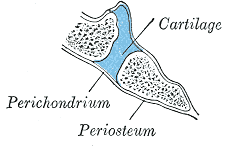Synchondrosis
Hyaline cartilage joint of two bones
A synchondrosis (or primary cartilaginous joint) is a type of cartilaginous joint where hyaline cartilage completely joins together two bones.[1] Synchondroses are different from symphyses (secondary cartilaginous joints) which are formed of fibrocartilage. Synchondroses are immovable joints and are thus referred to as synarthroses.are all synchondroses synarthrotic/immovable[citation needed]
| Synchondrosis | |
|---|---|
 Sagittal section through the clivus of the skull demonstrating the location of the spheno-occipital synchondrosis in an infant. | |
| Identifiers | |
| TA98 | A03.0.00.016 |
| TA2 | 1529 |
| FMA | 7497 |
| Anatomical terminology [edit on Wikidata] | |
Examples in the human body
Permanent synchondroses
- first sternocostal joint (where first rib meets the manubrium of the sternum)
- petro-occipital synchondrosis
Temporary synchondroses (fuse during development)
- epiphyseal plates
- apophyses
- synchondroses in the developing hip bone composed of the ilium, ischium and pubis
- spheno-occipital synchondrosis
References
- ^ Dixon, Andrew. "Synchondrosis | Radiology Reference Article | Radiopaedia.org". Radiopaedia. Retrieved 2020-06-12.
- v
- t
- e
Joints
- Fibrous
- Gomphosis
- Suture
- Syndesmosis
- Interosseous membrane
- Cartilaginous
- Synchondrosis
- Symphysis
- synovial: Plane joint
- 1°
- 2°
- 3°
- by range of motion: Synarthrosis
- Amphiarthrosis
- Diarthrosis
- Kinesiology
- Anatomical terms of motion
- Agonist/Antagonist
- general: Flexion/Extension
- Adduction/Abduction
- Internal rotation/External rotation
- Elevation/Depression
- specialized/upper limbs: Protraction/Retraction
- Supination/Pronation
- specialized/lower limbs: Plantarflexion/Dorsiflexion
- Eversion/Inversion
- capsular: Joint capsule
- Synovial fluid
- Synovial bursa
- Articular disk/Meniscus











